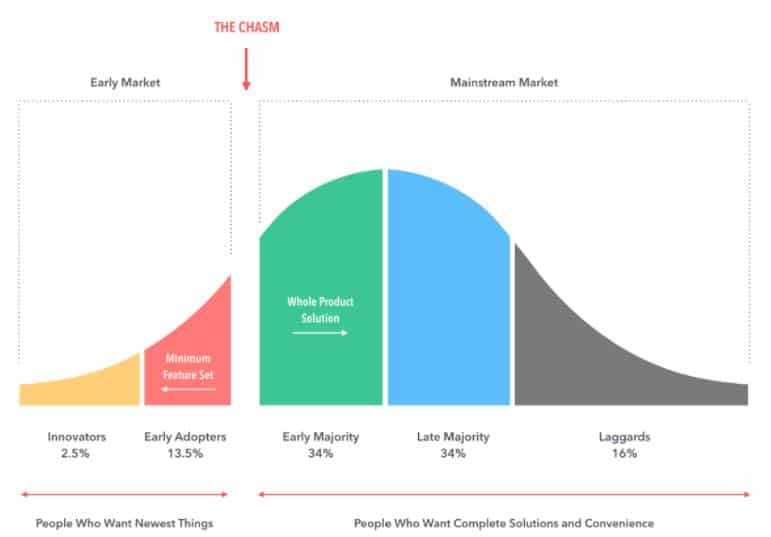by Amyn Amlani, PhD
In Part 1 of this series, the reader was introduced to the theory, Diffusion of Innovations (DOI; Rogers, 1962). DOI attempts to explain (i) how an idea or product or service gains momentum and diffuses (i.e., spreads) through a specific population or social system, and (ii) how categories of people (i.e., Innovators, Early Adopters, Early Majority, Late Majority, and Laggards) increasingly embrace new innovation(s) as part of their social system.
In Part 2 below, the reader is provided with information on Diffusion Chasm, and how this potential pitfall should be avoided by businesses.
The Chasm
In the DOI model, adoption is a continuous process whereby people increasingly embrace an innovation over time, as represented by the bell curve seen in Figure 1. As discussed in Part 1, each grouping of people represents a unique psychographic profile, and it these group differences that companies attempt to target through their marketing efforts. These efforts, in general, are often only moderately successful in generating brand awareness and sales.
Figure 1 below displays the technology adoption life cycle. Note that left-most portion of the distribution curve (i.e., Innovators [2.5%], Early Adopters [13.5%]) represents those individuals in the “early market” segment, while the remaining 84% of the distribution curve (i.e., Early Majority [34%], Late Majority [34%], Laggards [16%]) is labeled as the “mainstream market.”

Figure 1. Technology Adoption Life Cycle
In 1991, Geoffrey Moore contended that a chasm, or “spacing” (i.e., white-colored gap), exists between the Early Adopters and the Early Majority. According to Moore, this gap results from the two groups have differing psychographic profile with respect to needs, wants, and desires related to technology adoption.
Crossing the Chasm
To improve a product or service being adopted, businesses must lessen the chasm between the early market and mainstream market segments successfully. Failure to do so results in less-than-ideal adoption rates and a loss of potential revenue. According to Moore, crossing the chasm requires efforts to be shifted from “sales-driven” to “user-driven.”
Below are marketing considerations to consider when attempting to reach individuals in the early market segment:
- Early Majority segment users are characterized as:
- Pragmatists
- Accepting of change
- Having disposable income, yet seeking value for their purchase
- Prefer to buy from a category leader
- Process-oriented people
- Risk averse
- Loyal, once you have obtained their support, and
- Function as a “threat of barrier” to competitors entering the market.
- This segment seeks:
- New, proven products to improve productivity
- Products/services that reduce effort/cost
- Seamless integration within their existing life/process/routine
- Failure to integrate is a barrier to purchase intent
- Less likely to adopt without consulting others within this segment
- Marketing across the chasm lends to a “credibility gap”
- Long-term commitment from vendors, and
- A network of support services.
To attract the Early Majority, consider:
- The product or service offering should be easy to use and intuitive
- It must meet their basic needs seamlessly
- An offering with a lesser cognitive load
- No complex procedures that require memory recall
- A habit-forming product enables reduces considerable cognitive load
- If they are habituated, resistance to change increases
- Marketing messages to Early Majority segment must be completely different from those in the “Early Adopters” segment
- The means of adoption will be different, and
- The product should be dependable, of higher quality, and work without error.
What’s Next?
In this blog, the reader was introduced to the chasm that exists within the Diffusion of Innovation model. In the next segment of this installment, the concepts from Parts 1 and 2 will be applied to the hearing care space.






